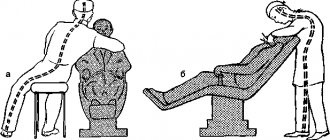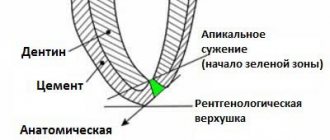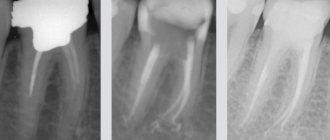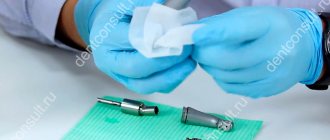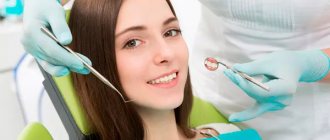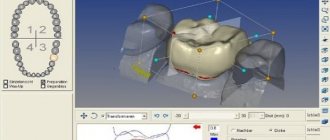General concept and rules of conduct
Irrigation is the cleaning and disinfection of the root canal of a dental element. Everyone who has visited the dentist at least once has encountered a similar procedure. Treatment of the oral cavity with a special device, from which liquid under pressure is supplied to the future area of work, allows you to reduce the concentration of bacteria and pathogenic microbes, eliminating the likelihood of inflammation developing when the cavity is opened.
In endodontic treatment techniques, irrigation is considered one of the key processes to get rid of excess microorganisms, residual dentin elements and tissues. In this case, the solution used should not provoke the patient to a negative reaction or stimulate the gag reflex. The choice of the optimal composition should be based on the results of tests that make it possible to identify the causative agent of the pathology - this requires diagnostics, including x-rays.
The procedure includes several manipulations performed by the dentist:
- external examination of the condition of the pulp and assessment of the periodontium;
- analysis of the tissue structure characteristic of the affected element;
- assessment of the specific structure of root canals;
- careful removal of the upper dentin layer;
- compliance with safety standards when working with aggressive compounds;
- consistent implementation of antiseptic procedures.
When planning to install a filling, the doctor should allocate at least five minutes for irrigation - this period is enough to clean the oral cavity from bacteria and possible pathogens. Otherwise, the risk of infection increases.
Dental clinic No. 2
Analysis of the reasons for the failure of endodontic treatment led to some rethinking of the meaning of its individual stages. Biological prerequisites, such as the complexity of the internal morphology of the tooth, as well as intracanal biofilm, force the search for new effective methods for cleaning root canals. And in this regard, the problem of high-quality root canal irrigation as the key to successful endodontics comes to the fore. The article provides a classification and brief description of the main irrigation techniques in endodontics, and provides practical recommendations for the use of the most popular of them.
If we analyze the scientific endodontic literature over the past few years, it becomes quite obvious that in the process of endodontic treatment, the irrigation phase is given great importance. Cleaning the root canal system of pulp residues, microorganisms and their toxins is a key point in treatment, without which it is impossible to hope for a successful result. The beginning of the clinical use of rotating N&T instruments was accompanied by a certain “euphoria” due to the “virtually unlimited capabilities” of these instruments. Indeed, most studies indicate a significant difference in the quality of root canal preparations performed with hand instruments and rotating N&T systems. However, the use of modern research methods, such as electron microscopy, computed microtomography, microbiological tests, etc., has shown that it is not possible to qualitatively clean the root canal system only through mechanical removal of infected dentin and pulp residues with manual or machine endodontic instruments possible.
Today, endodontic science has extensive information about the structure of the root canal system. It is known that the internal morphology of the tooth is extremely complex and diverse. A perfectly round cross-section, tapered root canal with a single apical foramen is perhaps the rare exception and not the rule. In the vast majority of cases, the canals have an irregular shape, different diameters in the buccolingual and mesiodistal directions, and numerous undercuts, the so-called “fins” (photos 1, 2). Oval or shaped canals are often found. In addition, many lateral tubules arise from the main canal at different levels. Lateral tubules are also found in the area of bifurcations and trifurcations of multi-rooted teeth. There are numerous anastomoses and isthmuses between the root canals, which are especially common, for example, between the medial canals of mandibular molars. The morphology of the apical third of the root is very complex. It is known that the main canal in the apical part forms a delta and opens at the root apex with not one, but several apical openings. Based on the above, it becomes obvious that such a complex system is not possible to clean only mechanically. In this regard, high-quality and effective irrigation of root canals becomes of great importance. Another major problem in root canal disinfection is intracanal biofilm. Its role in the prognosis of endodontic treatment is difficult to overestimate. According to the modern concept, microorganisms in root canals are present in the form of a bacterial biofilm, which significantly changes their properties and makes it difficult to eliminate them from the root canal system. Biofilm is a community of microorganisms surrounded by an extracellular polysaccharide matrix and attached to a moist surface. The biofilm protects the microorganisms present in it from the effects of adverse factors, creates conditions for reproduction; the polysaccharide matrix prevents the penetration of antibacterial agents into the biofilm, thereby increasing the resistance of microbes to antiseptics and antibiotics. Therefore, to eliminate biofilm, a combination of both a mechanical factor that can destroy the structure of the biofilm and a disinfectant that destroys its constituent microorganisms is necessary.
Thus, irrigation has two important goals:
cleansing the root canal system due to the chemical dissolution of organic and inorganic residues, as well as their mechanical washing out with a stream of liquid; disinfection of the root canal system.
In this regard, cleaning the root canal system should be considered as the most important stage of endodontic treatment, which has a significant impact on its prognosis. In turn, high-quality preparation and formation of the root canal helps create the necessary reservoir for the irrigation solution and opportunities for its activation.
All irrigation techniques can be divided into 5 groups:
manual; ultrasonic; sound (EndoActivator); laser (the solution is activated by a laser); hydrodynamic (RinsEndo, Endo Vac).
Manual irrigation
Traditional methods of irrigation using a syringe and endodontic needle provide satisfactory treatment of the coronal and middle third of the root canal, but are not sufficiently effective in terms of cleaning its walls in the apex area. For successful irrigation, it is necessary that the disinfectant solution be delivered to the entire working length of the root canal. This is not always possible to achieve with the help of classic endodontic syringes and needles, since in narrow root canals, due to surface tension, the irrigation solution does not reach the apex, leaving a so-called “air bubble”. As a result, the apical part of the root canal remains insufficiently processed. There are a number of simple rules and techniques that can make syringe irrigation more effective and predictable. The effectiveness of this type of irrigation is limited to a distance of 3-4 mm from the tip of the needle. Consequently, the closer the needle is advanced to the apex, the higher the quality of canal cleaning. On the other hand, the likelihood of the irrigation solution being carried beyond the apex also increases. In order to prevent this complication, it is very important to have some distance between the tip of the needle and the wall of the root canal (Fig. 1a, b). The next important points are the movements of the needle during the introduction of the irrigation solution, as well as the position of the syringe. The irrigation solution should be withdrawn slowly and carefully, while the needle should make reciprocating movements. It is recommended to press on the syringe piston with the index finger rather than the thumb, as tactile control is significantly improved (photo 3a, b).
The depth of needle penetration, in turn, is determined by the following factors:
the size of the apical preparation; channel taper; needle diameter.
The optimal size of the apical preparation for effective irrigation should be 30-40 according to ISO.6 The relationship between the apical size and taper can be schematically represented as follows (Fig. 2).
After completing the preparation of the canal with a hand file No. 25 (taper 2%), it can be assumed that its diameter at a distance of 3 mm from the apex will be 0.31 mm (0.25 + 0.02x3).
When using a rotating nickel-titanium instrument with the same tip size, but a 6% taper, the channel diameter at the same level will already be 0.43 mm (0.25 + 0.06x3).
At a distance of 10 mm from the apex, the difference will be even more significant - 0.45 and 0.85 mm, respectively. Thus, a pronounced taper significantly improves the efficiency of irrigation, creating an additional depot for the solution and allowing it to act throughout the canal (Fig. 3). The next important factor is the diameter of the needle. The diameter of needles is usually measured in units called gauge. The most commonly used endodontic needles are 27 gauge. It should be remembered that when determining the size of needles, an inverse relationship is observed. The larger the number in gauge, the smaller the needle diameter (Table 1). Thin needles Endo-Eze Tips and NaviTip (Ultradent) have a diameter of 29 gauge (0.28 mm), which allows them to be advanced as much as possible to the apex (photo 4).
A very important characteristic is the flexibility of the needle and the ability to pre-bend it when working in a canal with pronounced curvature.
To increase the effectiveness of manual (performed with a syringe) irrigation, a gutta-percha pin can be used, which is used to mechanically activate the irrigant in the pulp cavity and root canals9 (photo 5a, b). Company
Ultradent offers the NeviTip EfX endodontic attachment, which is both a needle and a brush for mechanical activation of the solution. Using NeviTip Effect, you can simultaneously carry out the stage of irrigation and mechanical cleaning of the canal from sawdust, old filling material or calcium hydroxide (photo 6, 7).
Ultrasonic irrigation
A very effective method of activating an irrigation solution is the use of passive ultrasonication. With passive ultrasonic irrigation, a thin wire or a small file, for example No. 15 or 20, is inserted into the root canal filled with solution (photo 8). Ultrasonic vibrations and the energy of the file are transferred to the liquid, which causes the occurrence of so-called acoustic cavitation. At the moment of rarefaction, cavitation bubbles appear in an intense sound wave, which collapse sharply when moving to an area of high pressure. In the cavitation region, powerful hydrodynamic micro-shock waves and micro-flows arise. In addition, the collapse of bubbles is accompanied by strong local heating of the liquid and the release of gas. Such exposure leads to the destruction of even such durable substances as steel and quartz. If sodium hypochlorite is used as a solution during passive ultrasonic irrigation, its antibacterial effect is significantly enhanced. In addition, local temperature increases also play an important role. Thanks to these effects, dentinal filings, pulp tissue and intracanal biofilm are removed (including due to the dissolving effect of NaOCl). In order to remove this suspension from the canal, you need 2 ml of fresh solution, which is injected from a syringe.
Practical recommendations for performing ultrasonic irrigation:
the size of the ultrasound file should not be more than 15, 20 according to ISO; the files used should not have a cutting surface to prevent transport of the canal (photo 9); the file should be inserted into the canal, 1.52 mm short of reaching the working length (photo 10); it is important to limit the reciprocating movements of the instrument in the canal and always pre-bend the file when working in curved root canals in order to prevent apical perforation and the formation of steps; the solution is sounded 3 times for 20 seconds, with the obligatory renewal of the irrigant in a volume of 1.5-2 ml.
Sonic irrigation
In addition to ultrasonic energy, sound vibrations are also used to activate the irrigant solution in the root canal. Compared to ultrasonic devices, sound devices generate vibrations of lower frequency but higher amplitude. As a result, the point contact of the sonic tip with the wall of the root canal does not actually affect the effectiveness of its work - unlike ultrasonic tips. A number of researchers have shown that sonic activation of the solution improves the quality of root canal irrigation compared to manual techniques. An example of a sound system for use in endodontics is the Endo Activator (Advanced Endodontics). An interesting design feature of this system is that it uses special polymer tips that do not have cutting properties and, therefore, avoid complications such as the formation of a step, transportation, and perforation of the root canal walls. In addition, the tips are disposable and can be easily selected and trimmed depending on the length and diameter of the root canal. On the other hand, the quality of treatment of the apical part of root canals using sound activation is still significantly inferior to that using passive ultrasonization.
Hydrodynamic irrigation
To improve the quality of treatment of the apical third of the root, the RinsEndo system from Duerr Dental (RinsEndo, Durr Dental, Germany) was also developed. RinsEndo is a handpiece that screws onto the turbine drive of the dental unit and uses compressed air pressure to propel the irrigant solution into the apical part of the root canal. A study conducted by W. Hauser et al demonstrated the high efficiency of cleaning the root canal walls with this system compared to traditional manual syringes. But at the same time, this work showed that the use of the RinsEndo tip significantly increases the likelihood of the irrigation solution being removed beyond the apex (80% versus 13% when using a conventional syringe), which is especially dangerous when using sodium hypochlorite solution as an irrigant due to the possibility of serious complications. Another option for solving the problem of insufficient cleaning of the apical third of the root canal is the use of systems based on creating negative pressure in the canal. An example of such a system is EndoVac from Discus Dental. The basis of traditional irrigation methods is the passive introduction of an irrigant solution into the root canal under the influence of positive pressure applied to the syringe plunger. The principle of operation of the Endo Vac system is based on the movement of the irrigation solution by creating negative pressure in the root canal. One of the nozzles, which supplies the irrigation solution, is inserted into the tooth cavity to a shallow depth, while the other cannula, which performs aspiration, is inserted into the root canal to its entire working length. As a result, the supplied solution, due to negative pressure, penetrates the entire working length of the root canal without the risk of being carried beyond the apex. The advantages of this technique compared to the traditional irrigation method have been confirmed by a number of scientific studies.
Activation of irrigant by laser radiation
A relatively new and interesting trend in root canal irrigation is photoactivated disinfection (PAD or PDT). The essence of the method is the introduction of a special dye - a photosensitizer - into the root canal, followed by irradiation using low-power laser radiation with a certain wavelength. Light-sensitive dye molecules (the most commonly used dye is tolonium chloride, or TBO) attach to or even penetrate the bacterial cell membrane. Then, under the influence of laser radiation with a certain wavelength (for tolonium chloride it is 633 nm), a chain of chemical reactions is launched, which results in the formation of free radicals, namely singlet oxygen. These active radicals cause disruption of the integrity of the bacterial cell wall, inactivation of bacterial toxins, degradation of essential proteins and DNA molecules, resulting in the death of the bacterial cell.8 The high antibacterial activity of photoactivated disinfection against both suspended cultures and bacterial biofilm has been demonstrated in a number of studies . The key point of this technique is the direct contact of photosensitizer molecules with the bacterial cell and its penetration into the bacterial biofilm. Consequently, as in the case of the use of traditional irrigation methods, the problem of delivering irrigant (dye) to hard-to-reach corners of the root canal system remains relevant.
Conclusion
In conclusion, I would like to note once again that today the endodontic treatment strategy is increasingly inclined to use the concept of the biological feasibility of the intervention. This approach, in turn, led to the need to improve methods of combating intracanal biofilm as the main reason for the failure of endodontic treatment. And the key point in this fight is high-quality irrigation of the root canal system.
Preparation and irrigation of the dental canal
A prerequisite for the procedure is preparation of the canal. During medical intervention, a cavity is formed, which is subjected to sterilization. Preparation involves partial removal of dental tissue, carried out mechanically, and allows you to solve the following problems:
- removal of pathological tissue from the root canal;
- providing an ideal environment for irrigation and sterilization;
- preservation of the natural anatomical structure of the canal;
- prevention of the spread of infectious pathologies;
- maximum possible preservation of the dentin layer.
After mechanical treatment, the doctor must evaluate the quality of the cleaning performed. If it meets the standards, you can move on to irrigation.
The number of solutions used for the procedure varies. Each composition has its own healing functions:
- water - used during mechanical cleaning, allowing you to rinse the oral cavity without causing a negative reaction in the body;
- sodium hypochlorite is a bactericidal composition that effectively removes bacteria and viral pathologies, and whitens enamel;
- hydrogen peroxide - used in combination with the previous solution, improving its disinfecting properties and increasing foaming;
- sodium dichloroisocyanurate – the antibacterial properties of the solution are higher than those of hypochlorite;
- acidic components - phosphoric and citric acid are not highly antiseptic, therefore they are used in combination with other compounds;
- chlorhexedine is the most effective agent against bacteria, but with low dissolving ability, which requires the additional use of hypochlorite.
Modern techniques are used for irrigation. Washing is carried out manually, using ultrasound, sound, laser or hydrodynamics. The most effective method is ultrasonication, during which an antiseptic solution is supplied into the cavity using ultrasound waves.
An important factor during the procedure is monitoring the temperature of the composition. Overheating of the irrigant causes a negative reaction in the body.
Requirements for irrigation solutions
To thoroughly clean the canals of organic and inorganic particles, it is important to use irrigants with proven effectiveness. Ideal disinfection formulations must meet the following requirements:
- act on various pathogenic microorganisms, including fungi,
- dissolve necrotic pulp and smear layer,
- fight endotoxins and anaerobic organisms in the biofilm,
- do not stain hard and soft tooth tissues,
- be safe for the human body.
No antiseptic solution is capable of destroying all metabolic products of bacteria and inorganic residues, therefore, several means are used to increase the efficiency of root canal irrigation.
Root canal disinfection
In an infected canal there are more than 108 bacteria for every millimeter of its contents. Instrumental treatment reduces the number of bacteria by 1000 times, and washing with sodium hypochlorite reduces the number of bacteria by another 50 times. Medicinal preparations under temporary dressings, applied after instrumentation and rinsing, can completely eliminate all remaining microorganisms and prevent secondary periodontal infection. Good results are obtained by using calcium hydroxide, which clears the canal of bacteria in 97% of cases. Lipopolysaccharides (endotoxins), released from bacteria after their destruction, are considered the main etiological factor in periapical tissue resorption. Calcium hydroxide destroys these lipopolysaccharides, which explains its antibacterial and antitoxic activity. Since chemical-mechanical treatment of canals does not remove all tissue from curved canals, temporary dressings help dissolve the tissue. Anaerobic conditions in a filled tooth do not affect the absorbable properties of the bandage. Calcium hydroxide successfully resolves pulp residues 7 days after application. 1 week after the introduction of this solution into the canal, the untreated odontoblastic layer is destroyed, and after 4 weeks, the predentin is destroyed. No further destruction of hard tissue occurs. When the drug is in the canal for 3 weeks, hydroxyl ions diffuse into the dentin. After just 24 hours, a maximum pH value of 10.8 is reached on the inner surface of the root canal. To remove calcium-containing drugs from root canals, Solutio Citric Acid 10% is used. Source: Endodontic dental treatment, Kuzmina D. A., Pikhur O. L., Ivanov A. S. 2010.
Related materials:
- Determination of the working length of the root canal
- Creation of endodontic access
- Anatomy of tooth root canals
- Diagnostics in endodontics
Who needs an irrigator
The use of an irrigator is useful for all people, but is especially indicated for preventive purposes:
- in the presence of braces, crowns, bridges and dentures in the oral cavity;
- when there is an abnormal position of the teeth or their crowding, when there are difficult-to-reach areas for a toothbrush;
- with multiple caries;
- with previously suffered gingivitis and periodontitis;
- in persons who have a tendency to form stones on their teeth;
- in heavy smokers;
- in persons with a tendency to bleeding gums;
- in persons suffering from diabetes mellitus and other metabolic disorders;
- in pregnant women.
What is irrigation in dentistry?
Unfortunately, a toothbrush and toothpaste are not enough to keep your teeth strong and healthy. There are hard-to-reach places in the mouth where germs accumulate. And this leads to the development of caries, periodontitis, gingivitis and other diseases. How to remove soft plaque and thoroughly clean your teeth? With the help of an irrigator! We will describe below what an irrigator is and how to use it.
Any patient who comes to a dental clinic knows that after each stage of treatment, the doctor rinses the mouth with a stream of water, sometimes adding disinfectant solutions such as furatsilin, chlorhexidine, chlorophyllipt, and calendula instead of water. The liquid is supplied to the mouth under a certain pressure, and thus prevents infection of the wound surface with tooth fragments. However, you can also use the irrigator at home.
There are three types of irrigators for the home:
- family
- with a large capacity for the whole family; - road
- a small device powered by a battery; - stationary
, connected to the mains.
When using an irrigator, all food debris and plaque are removed. Water jets can be different here: pulsating, bubbly and ordinary mono-jet. A monojet is a regular high-pressure jet of water that rinses the mouth. This technology is a little outdated, but is still used in some irrigators.
Today it has been proven that a very large percentage of the population suffers from periodontal tissue diseases throughout the world. Therefore, all patients are recommended to use an irrigator to cleanse the mouth to reduce the risk of dental disease. There are no contraindications to using the irrigator. The only contraindication is periodontal tissue disease in the acute stage and, accordingly, preschool children, because they do not yet have manual skills and persons who have removable or non-removable orthodontic structures in the oral cavity - these are, as a rule, bridges, crowns , braces, traction, splinting teeth, implants; persons with poor oral hygiene; persons who suffer from periodontal tissue diseases from the very beginning to the most severe degree of damage.
In conclusion, I would like to emphasize that the use of an oral irrigator reduces the risk of dental diseases, reduces the formation of bacterial plaque, stimulates the gums, stimulates blood circulation, and thereby patients achieve a reduction in inflammation in the oral cavity.
Effective means for drug treatment
The irrigation procedure in modern dentistry is performed using several drugs.
- Sodium hypochlorite has high antimicrobial activity, destroys the remains of damaged pulp and Candida fungi. Even in low concentrations, this compound destroys infected tissue.
- Chlorhexidine is a popular antiseptic that acts on fungi and bacteria of various types. It has a prolonged effect due to its ability to bind to dentin. It is odorless and does not irritate mucous membranes.
- EDTA destroys inorganic components in the root canals. In small concentrations it is highly biocompatible, which avoids damage to living tissues. Facilitates canal processing with hand tools and by machine.
Treatment of root canals with medications is carried out in stages. Irrigants are used sequentially, strictly controlling the concentration. This avoids sedimentation and channel blocking.
How to improve irrigation efficiency?
To improve the quality of root canal irrigation, specialists:
- carry out preliminary conical expansion of the channels,
- use various methods of activating irrigation solutions - ultrasonic, laser, etc.,
- increase the temperature of irrigants to improve their disinfectant properties,
- After finishing the work, dry the entire canal using paper points.
Strict adherence to endodontic treatment technology, high-quality preparation and irrigation of dental canals make it possible to destroy pathogenic microorganisms and remove organic and inorganic components. If the medical procedures are successful, the restored tooth will last as long as possible, and the risk of developing caries under the crown will be minimal.
How to use the device so as not to harm your health?
Do not use the irrigator if you have the following contraindications:
- rosacea (a disease in which the walls of blood vessels become thinner),
- injuries to the mucous membrane and neoplasms in the oral cavity,
- after gum surgery,
- for periodontal diseases in the acute stage,
- for chronic bleeding gums, within one to two days after installation of the orthodontic system,
- after a heart attack or stroke;
- if you have a pacemaker.
Using an irrigator can harm baby teeth, so dentists do not recommend using the device for children under six years of age.
Frequent use of an irrigator can cause thinning of the enamel and lead to increased tooth sensitivity. Depending on the condition of the gums, tooth enamel, and the presence of dental structures, the optimal frequency of use can vary from once a day to three times a week. Consult your dentist to determine a safe frequency of use.
Start cleaning with minimal water pressure, gradually increasing the pressure to comfortable values. Children should use the appliance at minimum power at all times.
Follow safety precautions and recommended rules for using the device.
Replace brush heads with bristles every three months, and without brush heads every six months. Never use other people's attachments. This will avoid infections, inflammation and other diseases of the oral cavity. Do not give up using a regular toothbrush, since a waterpik cannot replace this tool. It works effectively only in combination with a brush, paste and thread.
Following these simple recommendations will minimize the potential harm from using an irrigator and make oral care not only effective, but also safe.
How does the irrigator work?
The irrigator has a hydraulic pump, which, under pressure, pushes a stream of water through a handle with a nozzle. The following elements of its design are important for the user: the number and type of nozzles, the volume of the water container, the type of energy source, and the power of the device.
Types of nozzles
Stationary devices, depending on the model, have a large number of attachments that are used for different purposes:
- main nozzle for cleaning between teeth;
- for cleaning gum pockets (has a thin rubber tip);
- for cleaning the tongue (in the form of a spoon, which can be used to irrigate the tongue and scrape off the washing water);
- for cleaning braces and implants (with mini brush),
- for polishing teeth (in the form of a round rotating brush).
Is there any harm from using an irrigator?
Like any technical device, an oral irrigator should be used correctly, in accordance with the instructions for the device and the dentist’s recommendations.
Compliance with safety precautions, correct placement of the device in the mouth, optimal choice of power taking into account the age and characteristics of the teeth - all this is important for the safe use of the irrigator.
Potential harm is possible in several cases:
- use of an irrigator if there are contraindications;
- too frequent (more than 2 times a day) cleaning of the oral cavity;
- performing the procedure with too high water pressure;
- violation of safety regulations when using an electrical appliance;
- rare replacement or use of someone else’s attachments;
- using an irrigator as a complete alternative to a toothbrush.
To avoid causing harm to your teeth and oral cavity, before using the irrigator, carefully read the instructions and consult your dentist.

